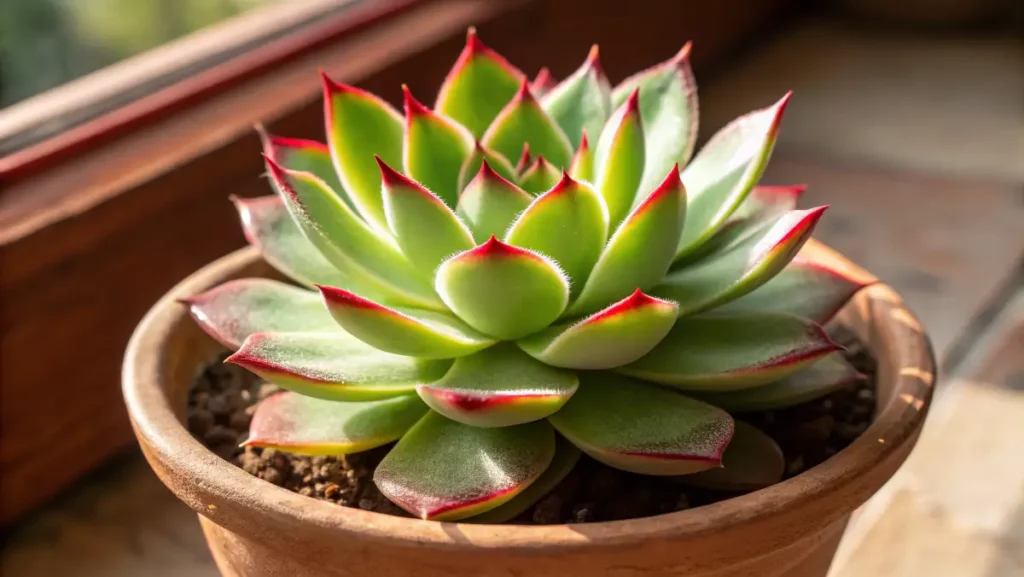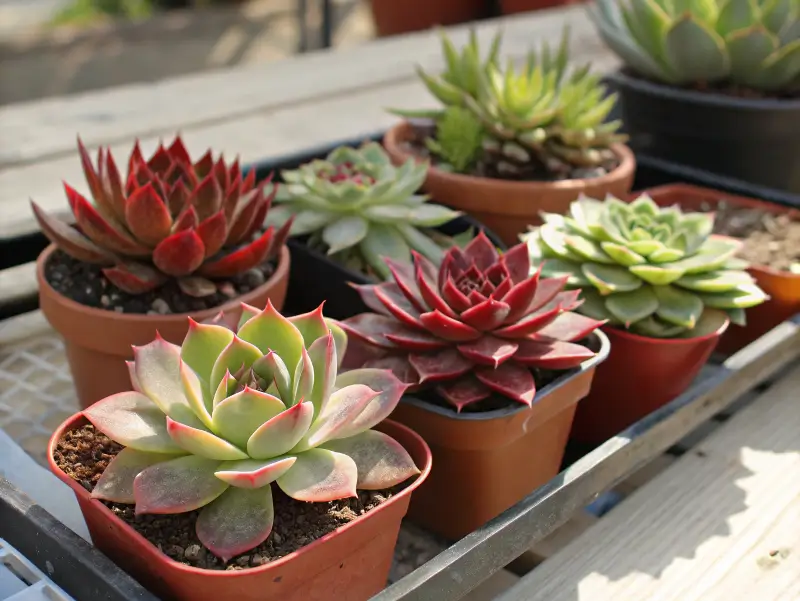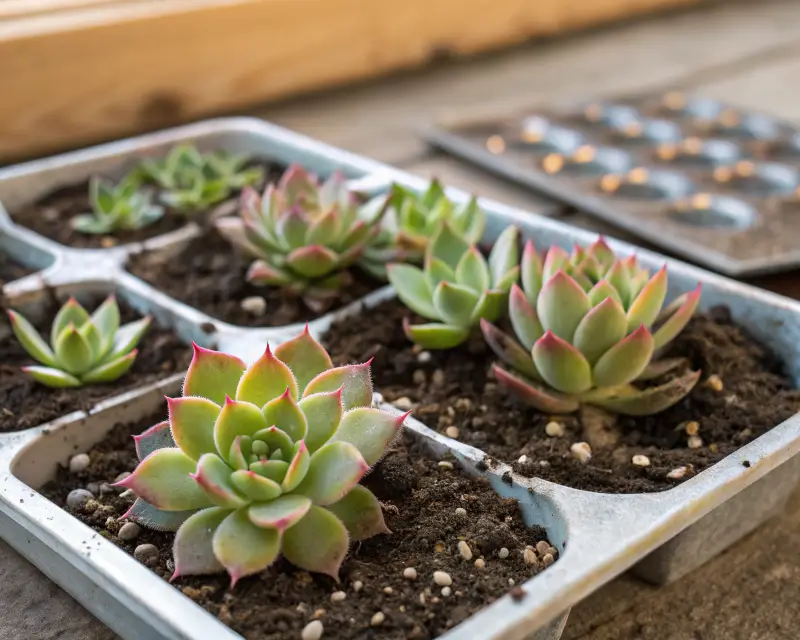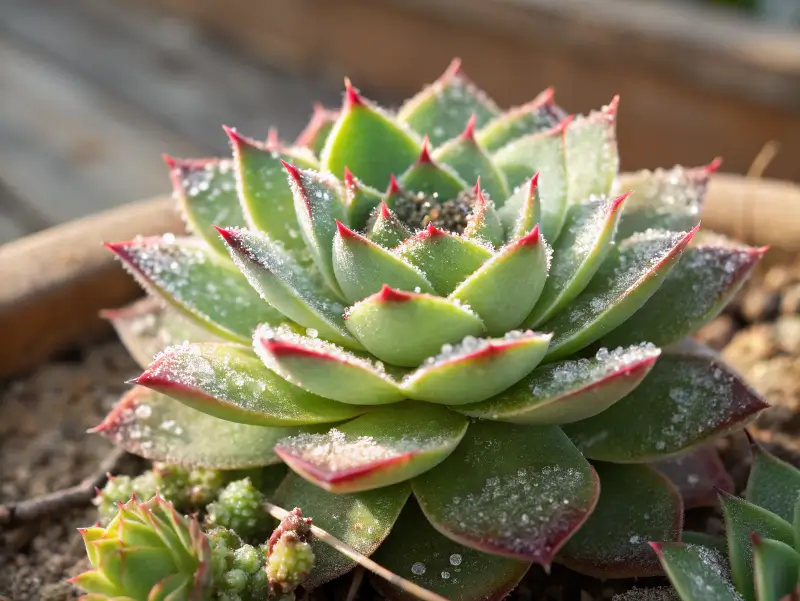
In This Article
Echeveria agavoides is a succulent prized for its bright green leaves tipped with crimson hues, forming a sculpted rosette. It grows slowly, eventually topping out around four to six inches tall and wide, making it a perfect windowsill companion. This sun-loving plant prefers moderate watering with proper drainage. Pet owners should note it can be mildly toxic if chewed. Overall, it’s an easy-care choice with a striking look.
Echeveria Agavoides Care
When it comes to caring for Echeveria agavoides, it helps to think of the desert life. This plant has adapted to hold water in its chubby leaves, so drowning it is surprisingly easy if you’re too keen on watering. Yet with a bit of awareness, you’ll find it wonderfully simple.
Light Requirements
Succulents typically adore the sun, and Echeveria agavoides is no exception. In fact, a few hours of direct light encourages that slight blush on the leaf tips, which many of us find so charming. A south- or west-facing windowsill is often the sweet spot indoors. Outdoors, a balance of direct morning sunlight and partial afternoon shade can help prevent sunburn.
- Too little light: The rosette grows taller and more spaced-out, losing that tight, symmetrical look.
- Too much intense light: Leaves can become scorched or develop sun-stressed patches.
Keep an eye on leaf coloration; if your Echeveria agavoides starts looking pale or washed-out, it might crave more direct sun or consistent bright light.
Watering Approach
Remember, these plants come from regions where water can be scarce, so soggy soil is a bigger threat than a bit of dryness. Follow the “soak-and-dry” plan:
- Water thoroughly so moisture reaches the root zone.
- Let the top few inches of soil dry out completely before the next watering.
- Reduce watering frequency in cooler seasons, because growth slows down and the plant sips less water.
Overwatering shows up in the form of mushy leaves that look translucent. Meanwhile, underwatering can make the foliage look slightly wrinkled or deflated. With a little experience, you’ll quickly learn how this succulent “talks” to you through its leaves.
Soil and Drainage
A quick-draining mix is your best friend here. A commercial cactus or succulent potting soil usually does the trick. Alternatively, combine standard potting mix with additions like perlite, coarse sand, or pumice to boost aeration. Echeveria agavoides relies on good drainage to ward off root rot. Make sure your pot has at least one drainage hole to let excess water escape.
Temperature and Humidity
Household temperatures of 65–80°F (18–27°C) keep these rosettes feeling right at home, and they don’t mind it if temps dip a bit at night. Just don’t expose your plant to extended frost. Dramatic cold snaps can cause irreversible damage to the leaves and root system. Humidity-wise, average indoor conditions are usually fine, but try to keep them away from constantly misty environments or poorly ventilated bathrooms if possible.
Fertilizer
While Echeveria agavoides isn’t particularly greedy for nutrients, a small feeding helps it stay lively and maintain plump leaves. Apply a balanced, half-strength fertilizer once a month in spring and summer. Be careful not to go overboard—too many nutrients may cause a leggy, stretched-out growth spurt that ruins its compact shape.
Types of Echeveria Agavoides

Variety is the spice of life, and Echeveria agavoides cultivars don’t disappoint. Each has its own color flair, though they all share that gorgeous rosette pattern:
- Echeveria agavoides ‘Romeo’
- Painted in rich red tones, giving it a dramatic flair that’s quite captivating.
- Echeveria agavoides ‘Ebony’
- Displays dark, almost black edges that contrast beautifully with the green center.
- Echeveria agavoides ‘Red Edge’
- The tips are more brightly outlined in red, emphasizing that classical Lipstick look.
- Echeveria agavoides ‘Corderoyi’
- Features softer green leaves with delicate pinkish tips, offering a subtler style.
Whether you collect just one or gather them all, each cultivar brings a lovely variation suitable for mixing and matching with other succulents. Try placing different varieties in a single arrangement for a rainbow of rosettes that’ll have everyone asking for your secret sauce.
Pruning
Pruning might not be the first thing that comes to mind with succulents, but a little upkeep keeps Echeveria agavoides looking tidy:
- Remove Spent Leaves: The lower leaves eventually shrivel as the succulent grows upward. Gently twist them off by hand or cut them with sterilized scissors.
- Snip Damage: If any leaves are heavily scarred, discolored, or pest-ridden, trim them off to maintain overall health.
- Clean Tools: Use a quick wipe with alcohol on your clippers or scissors. It’s easy to spread pathogens if you skip this.
In general, a quick pruning session every few months helps your succulent stay neat while preventing disease buildup beneath layers of decaying foliage. It also gives you a chance to check for pests or other issues lurking under those leaves.
Propagating Echeveria Agavoides

One of the joys of owning Echeveria agavoides is that you can multiply your collection—or share with friends—without too much hassle. Propagation methods are fun, educational, and can turn a single plant into a succulent family.
Leaf Propagation
This is an easy, beginner-friendly approach. Start by selecting a healthy leaf near the base of the succulent. Gently twist to separate it from the stem. Then lay the leaf flat on the surface of a well-draining medium. Leave the cut end to callus over for a few days. After that, lightly mist every week or so. Tiny roots and baby rosettes often appear within a couple of weeks. It’s super exciting to watch them grow!
Offsets (Pups)
Now and then, Echeveria agavoides will produce offsets around its base. When these pups reach about one-third the size of the main rosette, you can carefully detach them. Plant the offsets separately in small containers filled with succulent mix. A gentle watering schedule similar to the mother plant helps them settle in nicely. Pups are ideal if you want to create a quick grouping of uniform rosettes.
Stem Cuttings
If your Echeveria agavoides grows tall or looks stretched, take a stem cutting to form a fresh, compact plant. Snip just below the bottom leaves of the top rosette, then let the cut end callus for a few days. Plant it in well-draining soil, water sparingly, and watch for root development. It can take a few weeks, so patience is key.
Potting and Repotting Echeveria Agavoides
Echeveria agavoides isn’t fussy about pot size, but it does appreciate a container that accommodates its root system without drowning it in excess soil.
Choosing Containers
- Terra-Cotta Pots: Porous material that allows moisture to evaporate faster. Ideal if you have a tendency to overwater.
- Plastic and Ceramic Pots: Retain moisture a bit longer, so keep a closer eye on watering frequency.
- Drainage Holes: Always pick a pot with at least one hole. A reservoir of water at the bottom is a recipe for root rot.
Potting Mix
Whether you buy a cactus mix or make your own, the goal remains the same: keep it airy and well-draining. Combine standard potting soil with amendments like coarse sand, perlite, or pumice to let water flow out quickly. That way, your Echeveria agavoides avoids the dreaded soggy roots scenario.
When to Repot
- Root Bound? Roots bulging out the drainage hole or circling the topsoil mean it’s time to move up a size.
- Timing: Spring or early summer aligns with the plant’s growth season.
- How-To: Gently remove any loose soil, cut away rotted or dead roots, and replant in a fresh mix. Water sparingly after repotting, giving your succulent a week or so to settle.
A repotting day can be quite relaxing. Play some music, grab your tools, and reorganize your growing succulent collection. You could even pair Echeveria agavoides with a Yellow yucca plant for a diverse leaf combination on your plant stand.
Common Pests and Diseases

Even with its sturdy lineup of features, Echeveria agavoides sometimes faces uninvited guests. Checking under leaves during watering can help you catch problems early.
Pesky Insects
- Mealybugs: Look like bits of cotton stuck in leaf crevices. Dab them off with rubbing alcohol on a cotton swab.
- Spider Mites: Minuscule bugs that leave fine webbing on foliage. Boost ventilation, and consider a spray of neem oil or insecticidal soap if they persist.
- Aphids: Often cluster on new growth or flower stalks. A gentle rinse or insecticidal spray usually clears them.
Diseases
- Root Rot: Overwatering or heavy soils lead to mushy roots. Leaves at the base tend to turn translucent or wilt. Switching to a better-draining mix and cutting back on watering is the cure.
- Fungal Spots: High humidity or waterlogged leaves can cause splotches. Water at the soil level, avoid splashing the rosette, and keep good airflow.
When in doubt, the U.S. Department of Agriculture website has general plant health guidelines that can provide some reassurance or extra pointers.
Common Issues With Echeveria Agavoides
Despite its reputation as a low-maintenance succulent, Echeveria agavoides can still communicate displeasure if something’s off. Thankfully, most issues are easy to correct once you know the signs.
- Yellowing or Mushy Leaves
- Excess moisture around roots is the usual suspect. Let the soil dry thoroughly, and cut back on watering frequency.
- Leggy Growth
- Not enough sunlight. Move it to a bright window or add supplemental grow lights to tighten the rosette.
- Leaf Drop
- Can be triggered by pests, sudden temperature changes, or severe underwatering. Investigate and make gradual environmental adjustments.
- Brown Tips
- Usually from dryness or extreme heat. Slightly increase watering intervals or give it some midday shade if it’s in a scorching spot.
If you notice repeated problems, pause and review your day-to-day care. Succulents often provide visual clues that can guide you to fix the problem before it worsens. You might also link it up with other indoor plants. Personally, I enjoy placing Echeveria agavoides near an Angel wing begonia or an Aglaonema pictum tricolor for a vibrant, multi-textured display.
FAQ
How do you take care of Echeveria agavoides?
Provide plenty of bright light, maintain a well-draining soil mix, and water moderately—letting the soil dry between waterings. Fertilize lightly in spring or summer if you’d like an extra growth boost.
How big do they get?
They usually peak around four to six inches tall and wide, making Echeveria agavoides an outstanding pick for smaller ledges or clustered succulent gardens.
What is the difference between Echeveria and Agavoides?
“Echeveria” refers to the overall genus of rosette succulents, while “agavoides” is a specific species within that genus. The name points to its resemblance to tiny agaves.
How do you propagate Echeveria agavoides?
Leaves, offsets, or rosettes can all form new plants. Just remember to let cut ends callus over, plant in draining soil, and go light on watering at first.

1 thought on “Echeveria Agavoides: A Vibrant Guide to Growing and Thriving”
Comments are closed.